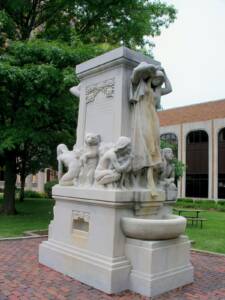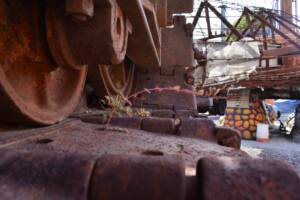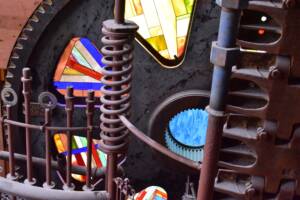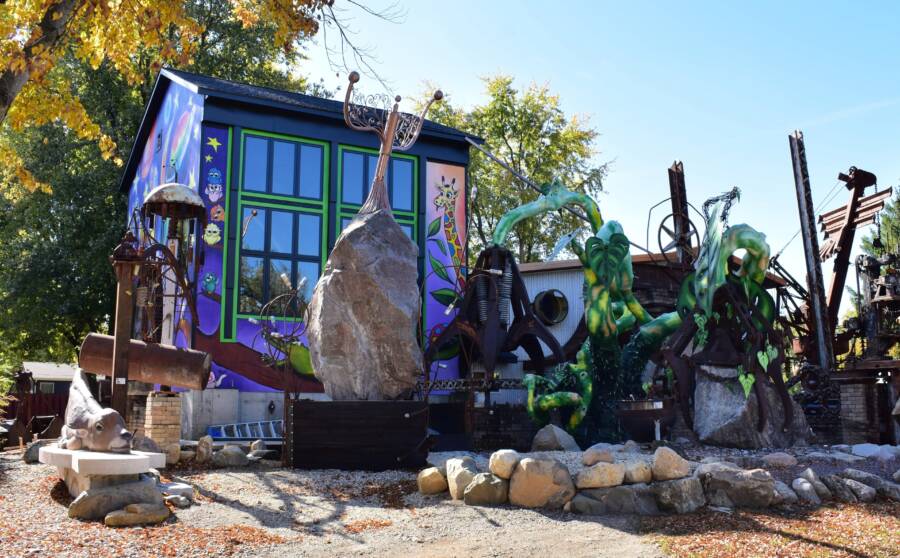The Bloomington-Normal art scene has a rich and layered history, one that reflects the community’s commitment to creativity and expression. What began with the founding of the Bloomington Art Association in 1870 has evolved into today’s thriving creative community, anchored by the same organization now known as the McLean County Arts Center. One of the oldest community arts organizations in the state, the organization has evolved over the decades to foster a community-wide appreciation for the arts.

Public art in Bloomington dates back to the early 1900s, when the Trotter Fountain was installed in Withers Park. This historic bronze piece still stands and is one of the oldest and most beloved examples of public art still featured in Bloomington today, symbolizing the city’s early embrace of beauty in shared spaces.
Meanwhile, in Normal, public art began to take shape as part of the town’s thoughtful approach to urban design. From the Normal Theater’s Art Deco façade to the contemporary sculptures that now accent the Uptown Circle, the community has continually woven art into everyday life, turning sidewalks, plazas, and public buildings into inspirational spaces.
Today, Bloomington-Normal’s public art continues to grow through partnerships between local artists, galleries, and arts organizations. Annual events such as the Around the Corner Art Walk, groups like the BN Artists, and a growing number of public art installations connect residents and visitors alike to a vibrant and ever-evolving art scene.
The Living Canvas: Public Art That Moves and Inspires
Among the many public art experiences in the Twin Cities, two stand out for their originality and immersive nature: The House on Garling and 410 Sculpture Park. Both are the work of local artist Tom Kirk, whose imagination and craftsmanship have transformed familiar materials into something entirely extraordinary.
410 Sculpture Park

410 Sculpture Park is an outdoor adventure that invites visitors to experience art in an interactive and thought-provoking way. Many of the installations feature upcycled materials paired with innovative techniques, creating works that are both eclectic and abstract with a balance of rough textures and whimsical expression.
The park encourages exploration, with each sculpture offering new perspectives on form and function. It’s a must-see for anyone interested in public art in Bloomington-Normal and how creativity can transform everyday materials into something extraordinary.
I keep extra material around—it doesn’t mean anything on its own, but when I find something interesting, I hold onto it. Later, when an idea hits, I can grab a piece or sometimes the piece itself sparks the idea. There’s never a master plan—just doing whatever feels right in the moment.
– Tom Kirk
The House on Garling

The House on Garling is a sensory experience that blurs the line between living space and art installation. Both the exterior and interior challenge the visitor’s perception of scale, texture, and material limits. Featuring welding by Kirk, his daughter Addison, and other collaborators, the house feels alive with creativity and experimentation.
While it’s easy to get swept up in the range of installations, the real intrigue lies in the details — rays of light through a stained-glass gear window or the countless small components that form a larger artistic vision.
Though the interior remains an ongoing project, visitors with timing on their side may be lucky enough to get a private tour when the artist is available.
I prefer to let people see what’s not there and find their own perspective. That big piece out front gets called the Magic Vine sometimes—it’s beautiful, kind of like a tree that’s shedding its bark. I wanted it to look like the vine was growing the rock, like it’s making its own pumpkins.
-Tom Kirk
A Community That Creates Together
From century-old sculptures to bold, modern installations, Bloomington-Normal’s public art reflects a community where creativity thrives. Every collaborative project tells a story — one of innovation, imagination, and a shared belief that art belongs to everyone.

